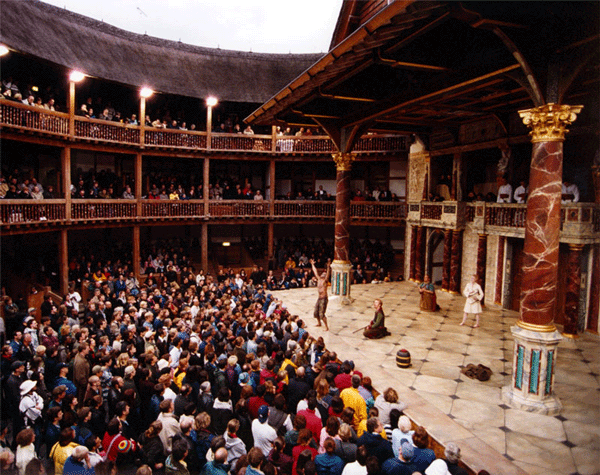Seriously seeking Shakespeare
 There he sits, the Bard, William Shakespeare, cast in bronze, enthroned forever atop his lofty pedestal. And as he observes the passing parade, with an expression frozen somewhere between serious concern and quizzical amusement, you can almost hear him chuckling, "What fools these mortals be."
There he sits, the Bard, William Shakespeare, cast in bronze, enthroned forever atop his lofty pedestal. And as he observes the passing parade, with an expression frozen somewhere between serious concern and quizzical amusement, you can almost hear him chuckling, "What fools these mortals be." Comfortably above the fray, the greatest playwright in the English language looks down on the bustling crowds, the gaily flowered walkways, the brightly painted canal barges, the gently flowing river and swaying willows that make up picture-postcard-perfect Stratford-upon-Avon.
It`s a sunny summer day, hot to the point of wilting by English standards, yet the town is a beehive of activity. The streets are alive with locals competing for space with the onslaught of camera-snapping, guidebook-reading, tour-bus taking tourists.
It`s a scene that has been repeating itself, in ever-increasing numbers, since the late 17th century, when literary pilgrims first began making the journey north from London to the little rivertown in Warwickshire. Many left their name in the guest book of the Birthplace (as it is known) or, like Edgar Allan Poe and the actress Ellen Terry, chose to etch their names directly into the house`s window panes.
The American author Washington Irving recorded on his visit in 1815 encountering the notorious Mrs. Hornby, the Birthplace`s resident tour guide, who was famous for making exaggerated historical claims and attributions to relics that included the sword Shakespeare used when he played "Hamlet" and the lantern with which Friar Laurence discovered Romeo and Juliet in the tomb.
But when the Birthplace, which had remained in private hands, came up for sale in 1847, it was purchased by the British government and ever since has been held in trust.
Today, just as those early tourists did, visitors to Stratford come to pay homage at the various stations of the Shakespeare tour. These include the recently reopened Birthplace (where Shakespeare was born in April 1564) adjacent to the new Shakespeare Center and museum; Trinity Church, where his body was interred following his death, April 23, 1616; New Place, where he retired after returning to Stratford from London; as well as the house of Mary Arden, his son-in-law, the doctor Thomas Nash, and Anne Hathaway`s cottage (located a little more than a half-mile out of town). Other historic structures of interest that are worthy of a visit are the Harvard House, the Garrick Inn and the quaint thatched cottages of Tavern Lane.
Theatergoers, of course, flock to Stratford because it is the second home of the Royal Shakespeare Company, which offers productions throughout the year.
Quaint and historic though it is, with its constant stream of gas-fume belching vehicular traffic, ersatz modern architecture butted up against Tudor relics, and passion for attaching cutesy Shakespearean monikers to every shop in town, it takes a real act of mental gymnastics to imagine Stratford as the place where young Will Shakespeare courted and sported, bedded then wedded Anne Hathaway.
And then there are the ubiquitous souvenir shops. Clustered like Venus` flytraps around every significant Shakespeare site, they lure the tourists in with promises of tangible remembrances of their visit. These establishments offer every conceivable type of Shakespeareana from elegantly bound editions of the Bard`s plays to the most embarrassing kitsch.
There is, however, one stop on the pilgrimage tour that cannot fail to impress - Trinity Church, dedicated in 1331. Nestled on the banks of the Avon, away from the hustle of the town center, it is the place in Stratford where the spirit of Shakespeare becomes most tangible. It is impossible to stand in the chancel of the church, looking down at the stone beneath which Shakespeare`s bones reside, daubed by brightly colored light from the stained-glass windows, and not experience a moment of revelation: that this man who has taken on the status of a marbleized icon was, indeed, mortal.THE GLOBE REVISITED
At exactly the same time that the visitors to Stratford are seriously seeking their Shakespearean experience, another equally enthusiastic band of devotees have gathered in London on the banks of an even mightier English river, the Thames. Exuding the type of excitement usually reserved for a thrill ride at Disneyland, this festive crowd is about to enter the city`s newest, and most popular, theatrical attraction - the re-creation of Shakespeare`s Globe.
The flag is up, and Vanessa Redgrave will soon stride onto the stage in "The Tempest," as Prospero. That`s right, Prospero! And as she makes her entrance, I half expect to see Simon Callow (the actor who played the Master of Revels in "Shakespeare in Love") storm into the theater in full Elizabethan garb and proclaim in no uncertain terms: "THAT MAN IS A WOMAN!"
Like the nobles of Shakespeare`s day, many of us have secured tickets that assure a seat on one of the theater`s rough-hewn, backless wooden benches beneath the rafters. For us, the play will be a reasonably "comfortable" experience (aided by the rental of a thick cushion - one pound, well spent). For the groundlings, however, whose tickets allow them standing room about the stage, the experience is one of endurance that may be dampened at any moment by inclement weather. And when the sky does open up, creating a mild tempest of its own, the groundlings must poncho-up and make the best of it.
It`s interesting to note that movements were afoot as far back as 100 years ago to create an exact replica of Shakespeare`s riverbank theater. But they came to nothing. It took the zealous efforts of a little-known American actor, Sam Wanamaker, to make the Globe project a reality. It was Wanamaker`s intense lobbying efforts and fund raising that finally got the ball rolling.
In 1987, the foundation for the theater was laid, 200 yards from the site of Shakespeare`s original "wooden O." Construction on the theater itself began in 1993, and the first official season was in 1997. Tragically, Wanamaker did not live to see his dream fulfilled. He died Dec. 18, 1993.
Rising 45 feet, the structure is a meticulous re-creation, as authentic as possible, with the exception of the electric lighting. In its completed form, the structure involved the crafting of 36,000 handmade bricks, the gathering of 6,000 bundles of Norfolk water reeds for the thatched roof, 180 tons of lime plaster for the walls, and nearly 185,000 yards of oak laths for the sides of the walls.
And while the statistics are fascinating, it is the fantasy of Shakespeare`s Globe that is most beguiling: the experience of being encapsulated within its circular walls, to watch the entrance of the actors onto the elaborately painted main stage with its faux marble columns, starry painted firmament and pair of amply endowed bare-breasted caryatids that flank the stage.
Unfortunately, on this night, one wishes the production were more attuned to its surroundings. Stagings in the past (I have been told) have paid strict attention to period accuracy in their staging of Shakespeare`s plays. But the play I am watching is a disappointment, a "Tempest" in a teapot. More contemporary, hip and politically correct than Elizabethan, the production`s director, Lenda Udovicki (of Belgrade), has managed to inject tango numbers and multiracial casting along with a hodgepodge of periods and costumes.
"What is the point," I keep asking myself, "of having this fabulous Shakespearean fantasy for a setting, if you`re not interested in going all the way to fulfill its potential?" This is the one theater in the world that could and should transport the viewer to the heart and soul of Elizabethan England. It is the theater that should devote itself to exploring authentic Shakespearean practices and stage techniques.
That certainly does not seem to be Udovicki`s goal, nor the goal of the theater`s artistic director, Mark Rylance. "Prospero`s island," Udovicki says in "The Tempest`s" program notes, "presents a gap in time and space; it gives us the opportunity to introduce into it things from different periods and regions." That may be an interesting interpretation, but it`s one that seems better suited to a company like the RSC or the avant-garde work at the Almeada.
The only element of Udovicki`s production that seems to capture the flavor of the era in which the play was first performed (1610) is the bawdy, rude interplay and improvisation between the clownish comic characters and the poor downtrodden slave Calaban (played by Jasper Britton) with the groundlings. Those too close to the stage find themselves splattered by various flying objects, including raw fish, and drawn into the action by the actors.
Ultimately, your visit to Shakespeare`s Globe or Stratford-upon-Avon may depend on how well you can overcome what might be called the Disneyland syndrome. It`s a topsy-turvy inversion of our visual acuity that has altered the way we see the world, to the point where it`s almost impossible not to see the quaint Tudor houses of Stratford or the festivities of the Globe Theatre through a Disneyfied filter of theme-park consciousness.
The irony is that even though Stratford is completely authentic, it looks and feels like Disneyland, while the Globe Theatre, which is at heart an architectural/theatrical folly of the first order, a constructed fantasy, rings true.
It`s an irony Shakespeare might have found amusing.IF YOU GO:
Globe, 21 New Globe Walk, Bankside, London. Nearest underground station, Mansion House on the Circle and District lines.
The 2000 season runs through Sept. 24. Seating is available in the upper, middle and lower galleries, as well as groundling standing room (open to the sky).
Tickets: 10-26 pounds (approximately $15-$39). For information: 020-7401-9919. Online: www.ticketmaster.co.uk, or www.shakespeares-globe.org.
Best information Web site: www.stratford-upon-avon.co.uk. Includes information on sightseeing, accommodations, historic points of interest, information on festivals, the Royal Shakespeare Company and more.
(c) Copley News Service
advertisement

Author: Jim Farber
Archives
Van Gogh and Gauguin together again
Harry`s Here
Memoir recalls courtship in Dachau
Mr. Smith goes to Hollywood
Moises Kaufman
And now ... the rest of the story
Finally, a time for Grandma
Homing in on Homer`s distinctly American flair
Gidget is back, and she`s original
Ego tours: rock and roles
Springtime for Brooks
The cradle does rock
Behind their music
Fluid approach to architecture is hallmark of modernist
New American plays mirror transitional theme
More Articles






